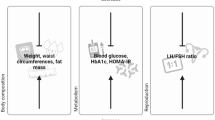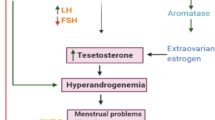Abstract
Purpose
Dyslipidemia, cardiovascular disease and hypertension are more frequently seen in patients with PCOS than in normal patients. We aimed at evaluating the distribution of Apo E alleles that can influence cardiovascular risk of the PCOS patients and control subjects.
Methods
In this study, 129 young women with PCOS and 91 healthy women were included. In all subjects we performed hormonal, biochemical and Apo E genetic analysis.
Results
The Apo E3 allele was found at a significantly higher frequency in the PCOS patient group compared with the control group. The Apo E2 allele was found at a significantly higher frequency in the control group compared with the patient group with PCOS.
Conclusions
Although there were genotype and allele differences between control and patient groups in this study, no statistically significant change was determined in lipid and other cardiovascular risk factors in connection with allele and genotype.
Similar content being viewed by others
Abbreviations
- ApoE:
-
Apolipoprotein E
- PCOS:
-
polycystic ovary syndrome
- BMI:
-
body mass index
- CI:
-
confidence interval
- CV:
-
coefficient(s) of variation
- MLRA:
-
Multiple Logistic Regression Analysis
- CVD:
-
cardiovascular disease
- DHEAS:
-
dehydroepiandrosterone sulphate
- E2 :
-
17ß-estradiol
- Hcy:
-
homocysteine
- 17-OHP:
-
17-hydroxyprogesterone
- P:
-
progesterone
- PRL:
-
prolactin
- T:
-
testosterone
- FSH:
-
follicle stimulating hormone
- LH:
-
luteinizing hormone
- HOMA-IR:
-
homeostasis model of assessment insulin resistance
References
Chang RJ. A practical approach to the diagnosis of polycystic ovary syndrome. Am J Obstet Gynecol. 2004;191(3):713–7. doi:10.1016/j.ajog.2004.04.045.
Knochenhauer ES, Key TJ, Kahsar-Miller M, Waggoner W, Boots LR, Azziz R. Prevalence of the polycystic ovary syndrome in unselected black and white women of the southeastern United States: a prospective study. J Clin Endocrinol Metab. 1998;83:3078–82. doi:10.1210/jc.83.9.3078.
Holte JL, Gennarelli G, Wide L, Lithell H, Berne C. High prevalence of polycystic ovaries and associated clinical, endocrine, and metabolic features in women with previous gestational diabetes mellitus. J Clin Endocrinol Metab. 1998;83:1143–50. doi:10.1210/jc.83.4.1143.
Wild RA. Obesity, lipids, cardiovascular risk, and androgen excess. Am J Med. 1995;98:27S–32S. doi:10.1016/S0002-9343(99)80056-4.
Chambers JC, Kooner JS. Homocysteine: a novel risk factor for coronary heart disease in UK Indian Asians. Heart. 2001;86(2):121–2. doi:10.1136/heart.86.2.121.
Utermann G. Apolipoprotein E polymorphism in health and disease. Am Heart J. 1987;113:433–40. doi:10.1016/0002-8703(87)90610-7.
Reilly SL, Ferrell RE, Sing CF. The gender-specific apolipoprotein E genotype influence on the distribution of plasma lipids and apolipoproteins in the population of Rochester, MN. III. Correlations and covariances. Am J Hum Genet. 1994;55(5):1001–18.
Smith JD. Apolipoprotein E4: an allele associated with many diseases. Ann Med. 2000;32:118–27. doi:10.3109/07853890009011761.
Hatters DM, Peters-Libeu CA, Weisgraber KH. Apolipoprotein E structure: insights into function. Trends Biochem Sci. 2006;31:445–54. doi:10.1016/j.tibs.2006.06.008.
The Rotterdam ESHRE/ASRM-Sponsored PCOS consensus workshop group. Revised 2003 consensus on diagnostic criteria and long-term health risks related to polycystic ovary syndrome (PCOS). Hum Reprod. 2004;19(1):41–7. doi:10.1093/humrep/deh098.
Matthews DR, Hosker JP, Rudenski AS, Naylor BA, Treacher DF, Turner RC. Homeostasis model assessment: insulin resistance and beta-cell function from fasting plasma glucose and insulin concentrations in man. Diabetologia. 1985;28:412–9. doi:10.1007/BF00280883.
Bhattacharya SM. Metabolic syndrome in females with polycystic ovary syndrome and International Diabetes Federation criteria. J Obstet Gynaecol Res. 2008;34(1):62−6.
Tarkun I, Arslan BC, Cantürk Z, Türemen E, Sahin T, Duman C. Endothelial dysfunction in young women with polycystic ovary syndrome: relationship with insulin resistance and low-grade chronic inflammation. J Clin Endocrinol Metab. 2004;89(11):5592–6. doi:10.1210/jc.2004-0751.
Tarkun I, Cetinarslan B, Türemen E, Sahin T, Cantürk Z, Komsuoglu B. Effect of rosiglitazone on insulin resistance, C-reactive protein and endothelial function in non-obese young women with polycystic ovary syndrome. Eur J Endocrinol. 2005;153(1):115–21. doi:10.1530/eje.1.01948.
Karadeniz M, Erdogan M, Berdeli A, Tamsel S, Saygili F, Yilmaz C. The progesterone receptor PROGINS polymorphism is not related to oxidative stress factors in women with polycystic ovary syndrome. Cardiovasc Diabetol. 2007;5(6):29. doi:10.1186/1475-2840-6-29.
Karadeniz M, Erdogan M, Berdeli A, Saygili F, Yilmaz C. 4G/5G polymorphism of PAI-1 gene and Alu-repeat I/D polymorphism of TPA gene in Turkish patients with polycystic ovary syndrome. J Assist Reprod Genet. 2007;24(9):412–8. doi:10.1007/s10815-007-9160-7.
Pirwany IR, Fleming R, Greer IA, Packard CJ, Sattar N. Lipids and lipoprotein subfractions in women with PCOS: relationship to metabolic and endocrine parameters. Clin Endocrinol (Oxf). 2001;54(4):447–53. doi:10.1046/j.1365-2265.2001.01228.x.
Wild RA, Painter PC, Coulson PB, Carruth KB, Ranney GB. Lipoprotein lipid concentrations and cardiovascular risk in women with polycystic ovary syndrome. J Clin Endocrinol Metab. 1985;61:946–51.
Ehrmann DA, Schneider DJ, Sobel BE, Cavaghan MK, Imperial J, Rosenfield RL, Polonsky KS. Troglitazone improves defects in insulin action, insulin secretion, ovarian steroidogenesis, and fibrinolysis in women with polycystic ovary syndrome. J Clin Endocrinol Metab. 1997;82:2108–16. doi:10.1210/jc.82.7.2108.
Scuteri A, Najjar SS, Muller D, Andres R, Morrell CH, Zonderman AB, Lakatta EG. ApoE4 allele and the natural history of cardiovascular risk factors. Am J Physiol Endocrinol Metab. 2005;289:E322–7. doi:10.1152/ajpendo.00408.2004.
Stiefel P, Montilla C, Muniz-Grijalvo O, Garcia-Lozano R, Alonso A, Miranda ML, Pamies E, Villar J. Apolipoprotein E gene polymorphism is related to metabolic abnormalities, but does not influence erythrocyte membrane lipid composition or sodium-lithium countertransport activity in essential hypertension. Metabolism. 2001;50:157–60. doi:10.1053/meta.2001.19429.
Heinonen S, Korhonen S, Hippeläinen M, Hiltunen M, Mannermaa A, Saarikoski S. Apolipoprotein E alleles in women with polycystic ovary syndrome. Fertil Steril. 2001;75(5):878–80. doi:10.1016/S0015-0282(01)01691-0.
Ross R. Atherosclerosis—an inflammatory disease. N Engl J Med. 1999;340:115–26. doi:10.1056/NEJM199901143400207.
Ridker PM, Buring JE, Shih J, Matias M, Hennekens CH. Prospective study of C-reactive protein and the risk of future cardiovascular events among apparently healthy women. Circulation. 1998;98:731–3.
Atiomo WU, Bates SA, Condon JE, Shaw S, West JH, Prentice AG. The plasminogen activator system in women with polycystic ovary syndrome. Fertil Steril. 1998;69:236–41. doi:10.1016/S0015-0282(97)00486-X.
Wilson PWF, Schaefer EJ, Larson MG, Ordovas JM. Apolipoprotein E alleles and risk of coronary disease: a meta-analysis. Arterioscler Thromb Vasc Biol. 1996;16:1250–5.
Srinivasan SR, Ehnholm C, Elkasabany A, Berenson G. Influence of apolipoprotein E polymorphism on serum lipids and lipoprotein changes from childhood to adulthood the Bogalusa Heart study. Atherosclerosis. 1999;143:435–43. doi:10.1016/S0021-9150(98)00304-9.
Komatsu F, Hasegawa K, Watanabe S, Kawabata T, Yanagisawa Y, Kaneko Y, Miyagi S, Sakuma M, Kagawa Y, Ulziiburen C, Narantuya L. Comparison of electrocardiogram findings and lifestyles between urbanized people and ger-living people in Ulaanbaatar, Mongolia. Atherosclerosis. 2004;175:101–8. doi:10.1016/j.atherosclerosis.2004.03.005.
Ordovas JM. Nutrigenetics, plasma lipids, and cardiovascular risk. J Am Diet Assoc. 2006;106:1074–81. doi:10.1016/j.jada.2006.04.016.
James RW, Boemi MG, Giansanti R, Fumelli P, Pometta D. Underexpression of the apolipoprotein E4 isoform in an Italian population. Arterioscler Thromb. 1993;13:1456–9.
Bailleul S, Couderc R, Landais V, Lefevre G, Raichvarg D, Etienne JV. Direct phenotyping of human apolipoprotein E in plasma: application to population frequency distribution in Paris (France). Hum Hered. 1993;43:159–65. doi:10.1159/000154172.
Davignon J, Gregg RE, Sing CF. Apolipoprotein E polymorphism and atherosclerosis. Arteriosclerosis. 1988;8(1):1–21.
Kolovou GD, Daskalova DC, Hatzivassiliou M, Yiannakouris N, Pilatis ND, Elisaf M, Mikhailidis DP, Cariolou MA, Cokkinos DV. The epsilon 2 and 4 alleles of apolipoprotein E and ischemic vascular events in the Greek population-implications for the interpretation of similar studies. Angiology. 2003;54(1):51–8. doi:10.1177/000331970305400107.
Sklavounou E, Economou-Petersen E, Karadima G, Panas M, Avramopoulos D, Varsou A, Vassilopoulos D, Petersen MB. Apolipoprotein E polymorphism in the Greek population. Clin Genet. 1997;52(4):216–8.
Olivieri O, Martinelli N, Bassi A, Trabetti E, Girelli D, Pizzolo F, Friso S, Pignatti PF, Corrocher R. ApoE epsilon2/epsilon3/epsilon4 polymorphism, ApoC-III/ApoE ratio and metabolic syndrome. Clin Exp Med. 2007;7(4):164–72. doi:10.1007/s10238-007-0142-y.
Acknowledgements
We would like to thank Hatice Uluer for her assistance in statistical evaluation of this study. We are thankful to Technicians of Nail Tartaroglu Endocrinology Laboratory for their assistance in coordinating this study.
Author information
Authors and Affiliations
Corresponding author
Rights and permissions
About this article
Cite this article
Cetinkalp, S., Karadeniz, M., Erdogan, M. et al. Apolipoprotein E gene polymorphism and polycystic ovary syndrome patients in Western Anatolia, Turkey. J Assist Reprod Genet 26, 1–6 (2009). https://doi.org/10.1007/s10815-008-9280-8
Received:
Accepted:
Published:
Issue Date:
DOI: https://doi.org/10.1007/s10815-008-9280-8




